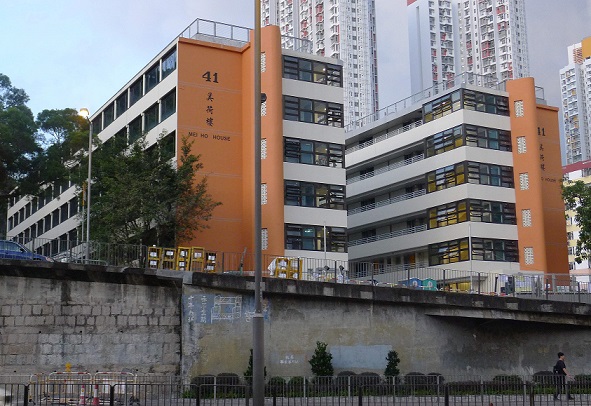Reviews & Articles
'Renewed' does not always mean 'improved'
John BATTEN
at 4:01pm on 12th August 2013


Captions:
1. Rene Burri, A worker showing his family the capital on Inauguration Day, Brasilia, Brazil, 1960. Photo: © René Burri/ Magnum Photos.
2. Hong Kong’s ‘revitalised’ Mei Ho House, Shek Kip Mei, 2013. Photo: John Batten.
(中文翻譯請往下看 Please scroll down to read the Chinese translation.)
As Hong Kong hosts an exhibition of René Burri’s evocative, historic photographs, John Batten ponders on what has been lost through another lacklustre ‘revitalisation’ attempt in the territory.
There is much beauty in René Burri’s architecturally-themed photographs, which are on exhibition until 25 August 2013 at the Hong Kong University Museum. The 80-year-old Swiss photographer is a master of expressing the architectural form and the nonchalant order of objects seen on the street using the fundamental tools of photography: light and shadow.
Burri documented the construction of Brasilia, the capital of Brazil, built in a frantic 41 months and opened in 1960. It was spearheaded by urban planner Lúcio Costa, landscape architect Roberto Burle Marx and featured the Modernist brilliance of architect Oscar Niemeyer’s individual buildings. Burri captures the wonder of this architectural and engineering achievement through the eyes of visitors to the new capital: a family wearing their ‘Sunday best’ stands to simply marvel.
The construction of Brasilia was fed by post-war optimism and a determination to build needed infrastructure. It was a time of great pride, optimism and technological advancement. Modernity was being introduced to the ‘Third World’ and its emerging nations. At the same moment, Hong Kong faced similar dilemmas. The influx of people after the defeat of Japan in 1945 and the conclusion of the Nationalist-Communist civil war in 1948 saw great strains on Hong Kong’s existing infrastructure.
In 1954, the world’s largest public housing programme was inaugurated with the opening of Mei Ho House in Shek Kip Mei. There would have been much wonder by its residents for their new accommodation, many who had only recently been precariously living on boats and in hillside squatter areas. But what would they say of the recently ‘revitalised’ Mei Ho House?
A Shek Kip Mei resident told me he was angry that Mei Ho House’s history had been stripped and cleaned off; its original form transformed by mirrored glass and the enclosure of its airy front balconies. For 60 years, Mei Ho House was a dignified presence on Tai Po Road and a tribute to difficult, but optimistic times. Now it is an emasculated memory, renovated for youth hostel tourists.
「重建」不盡若「改善」
當René Burri那充滿舊日情懷的歷史照片在港展出之際,百德約翰反思了本地又一乏善足陳的「活化」規劃,為歷史白白流失而嘆息。
香港大學美術博物館現正展出René Burri以建築為題的美麗照片,展期至8月25日為止。這位年屆80的瑞士攝影師擅長表現建築的形態,並突出街頭事物隱含的秩序,靠的是攝影的根本:光與影。
在1960年,巴西首府巴西利亞正式落成,而René正好見證了此前41個月瘋狂的大興土木。整個建造工程由城市規劃師Lúcio Costa與園景設計師Roberto Burle Marx主導;當中由Oscar Niemeyer設計的現代主義建築更是焦點所在。透過記錄一家人穿戴整齊地在巴西利亞遊歷的經過,雷尼巧妙地從遊客的角度,拍下當地於建築和工程上的奇妙壯舉。
戰後的樂觀期許,加上建造基建的決心,成就了巴西利亞的建造工程。當時,巴西凝聚了強烈的自豪感和憧憬,技術發展亦一日千里。現代化風潮亦席捲「第三世界」和其他新興國家。然而在同一時期,香港亦面臨類似的困境。兩道難民潮分別在1945年日本戰敗後和1948年國共內戰結束後湧入香港,為當時的本地基建帶來巨大的壓力。
在1954年,石硤尾美荷樓正式啟用,成為當時世界上最大的公共房屋計劃。當時,不少之前居於船上或山邊寮屋區的美荷樓居民都對他們的新居感到好奇。而對最近重新被「活化」的美荷樓,他們會說甚麼﹖
一位石硤尾居民對我說,他對美荷樓的歷史被剝奪、掏空感到十分生氣;新的鏡面玻璃大大改變了建築本來的形態,各層通風的陽台亦都被封閉了。 60年來,美荷樓默默佇立於大埔道,不但見證了從前的艱苦時期,亦象徵了前人的尊嚴和衝勁。現在,它卻淪為一段被閹割的記憶,成了單為青年旅社住客而設的空殼。
Chinese Translation: Teresa Chow
Exhibition:
René Burri : UTOPIA
This article was originally published in Perspective architectural magazine, August 2013.
